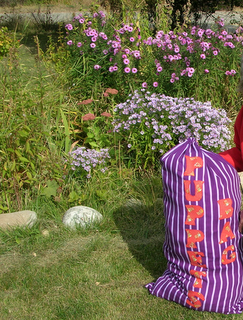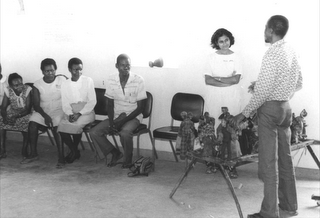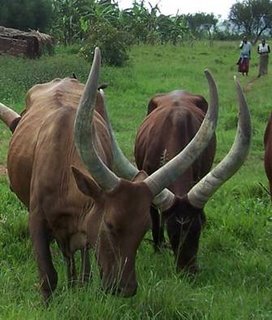Puppets for Health
 I have been on the outlook for puppets. I have been assisting in a child health project in Uganda for a couple of years. In collaboration with our partners, the Mbarara University of Science and Technology, a new medical school in Uganda, we have recently finalized Child Health training manuals for our community volunteers and trainers. The training manuals integrate the knowledge the community volunteers need with the techniques they can use to inform and educate people in the community. (I have a pdf version of both the trainer and CORPS manual I would be pleased to share with anyone interested but don’t know how to embed it on the post, so you will have to email me.)
I have been on the outlook for puppets. I have been assisting in a child health project in Uganda for a couple of years. In collaboration with our partners, the Mbarara University of Science and Technology, a new medical school in Uganda, we have recently finalized Child Health training manuals for our community volunteers and trainers. The training manuals integrate the knowledge the community volunteers need with the techniques they can use to inform and educate people in the community. (I have a pdf version of both the trainer and CORPS manual I would be pleased to share with anyone interested but don’t know how to embed it on the post, so you will have to email me.) 
The manual draws upon our experiences with the first volunteers, or Community Owned Resouce Persons (CORPs) as they are called. As you can see from the picture on the cover of our CORPs manual, the volunteers, in blue T shirts, are very adept in drama, even attracting audiences of children when they are practicing.
We have managed to implement all the various training techniques such as role playing, drama, story telling, demonstration, flannel boards and small group discussion. But we have yet to introduce puppets effectively. This was mainly because we didn’t have puppets to demonstrate how to do it.
The thing about public health messages -- wash your hands, immunize your child before one year of age and boil your water—is that they are boring. Important, of course! But soporific! We need puppets as well as drama, humour and storytelling to make them more interesting and to increase their impact and adoption. Hence the search for puppets.

Now, I am a great lover of thrift shops. So I began my search for puppets in thrift shops. This choice also fits nicely with our project budget. But over the course of a couple of months, I located but a few puppets. When I lamented about the dearth of puppets in thrift shops in my area to my sisters, they offered to help. On my recent trip back to the prairies they overwhelmed me with their success. In six short months between the two of them they had located more than 250 puppets.
My youngest sister had made colourful sturdy cotton bags brightly decorated with cut-out fabric stencils spelling, Puppets Bag, which will be given to the health centers. And I returned home, the proud possessor of five large sacks stuffed to the brim with freshly washed, recycled hand puppets.

The puppets include homemade versions sewn from hopsacking, classic versions of Punch and Judy with plastic heads and long flowing dresses, rubber dinosaur heads, plush dogs of all breeds, fleecy rabbits, Shari Lewis’ Lambchops and The Cat in the Hat. There are crocheted animals, felt finger puppets and renovated pajama sacs. A number of the puppets fit over all five finger including a banana with three monkeys, Noah’s Arc with four animals, and an octopus with tentacles. There are a number of African animals, lions with ferocious manes, zebra with prancing hooves, crocodiles with sharp teeth, a giraffe with a long neck, elephants with long trucks and pink ears and a whole carnival of monkeys. The safari animals will be especially suitable since our project in southwestern Uganda lies adjacent to a number of game parks.
There is a single gorilla. I have plans for him. While our project is near the famous gorilla sanctuary, close to the Rwandan border, few if any of the kids will have seen a gorilla. It is time we started talking about them.
Puppets will create an opportunity for our CORPs to take their messages to schools. It will help them to engage children in assisting us to get the message to the community. In Africa, children are often the caretakers of younger children. This observation led David Morley, a British pediatrician who authored the classic text, Pediatric Priorities in the Developing World, to develop a program called Child to Child. Based in the Institute of Child Health that he founded in London, the Child to Child program produces simple training material related to health that can be used to reach children of school age as well as a newsletter. It has been a revolutionary idea and one with sizeable impact in Africa.
Besides the hand puppets, we have also collected a few masks. Our manuals have a number of exquisite illustrations of puppets done but unfortunately Blogger can't handle them.
There is a challenge for us regarding the puppets. Our project is very concerned about being sustainable. International funding in such ventures follows its own directions. We have been lucky so far and have managed to secure five year funding to extend our project to several new areas. The Ugandans recognize that what we do needs to be carried forward by the people themselves. Lugging five sacks of fleecy children’s toys into Uganda is the antithesis of sustainable.

I have, however, a plan. I am proposing that the project hold a puppet making workshop. I have done this once before in eastern Uganda. We involved a local puppeteer who brought along his creations and was very interested in creating stories related to health. The puppets that people constructed at the workshop were exquisite in design and made from local materials such as the clay from anthills, dyes from local plants, brushes made from the sisal plant. I have an artist friend who may be able to help with this. This way the puppets would reflect African tales and local realities.
Having African puppets made by Africans will also help me to deal with another odd problem. I know the kids are going to laugh at the cow puppets I have found, all of which have short, stubby horns. Ankole cattle, which are much prized in southwestern Uganda, have elegant long horns that extend like a lyre above their head. The solution is to make African puppets drawn from their own world.
Now that I think of it, Ankole cows are all individually named. People not only talk about them frequently but they talk to them. I could see a wonderful drama of two cow puppets talking about how well cared for they are. Yes indeed. In even more grandiose moments, I see making puppets as one of the much needed income generating activities in the region. That would make them truly Puppets for Health. This is bound to be fun.
Photos: Puppet bag by 1st Sister;Cover of CORPS training manual; Puppet stash of 2nd Sister; Puppet Man; Ankole cow.
Labels: Uganda


6 Comments:
What a great idea, and how engaging for the children! You do such good work.
This is wonderful! It's got to have a really large impact!
Thanks for sharing this! :o)
What a great project. I have been looking for a charity to direct "gift money" toward this Christmas season. This really is worthwhile, as is the goal of local sustainability.
I'm going to write to you separately, but I had to say what an excellent and timely post this is. There is an outside chance that I may be working somewhere in Africa for a while next year (I know - an entire continent and the best that I can come up with is somewhere. I had been wondering whether I would need to adapt the techniques that I teach to make them less dependent upon explaining physiology and more about education through story-telling. In addition, I was thinking that I might have to abandon the methods that rely on a time-piece and use some other method of measurement. I've been looking around to see where I might find more information about how to teach health messages/techniques - and this post appeared in PGR.
I can't tell you how timely this post is. Please look out for an email from me.
Regards - Shinga
TundraPA and Moof thank you always for dropping by.
Ruth- It is good to have you comment.
Thank you for your generous suggestion. Our project has tax deductible status through the Canadian Pediatric Society website, where one can donate to Healthy Child Uganda directly. If you have trouble let me know.
Shinga-
You are right to emphasis story telling and drama. We do an exercise you will find in our manual to teach moms how to distinguish "fast breathing" in young children so they can identify when to go to health units for treatment.
A stone is tied to the end of a piece of string and swung from shoulder height as a pendulum. The length of string is determined so the rate is that of an adult. The length is then shortened at a knot placed in advance so it is that of a well child. The string is then shortened again so that the back and forth of the pendulum as it is swung from the should approximates the rate of a child with "fast breathing".
This experiential technique allows mothers to be able to tell regular from "fast" breathing in much the same way medical students through repeated observation, learn to identify it without a watch.
We have had some discussion in our project about the right length of string and how the stone in launched or simply dropped, until we reached our own conclusion about the length of each knot.
Post a Comment
<< Home